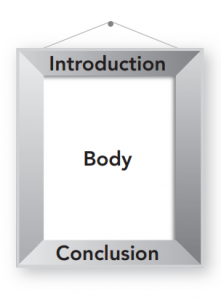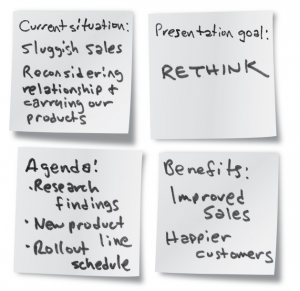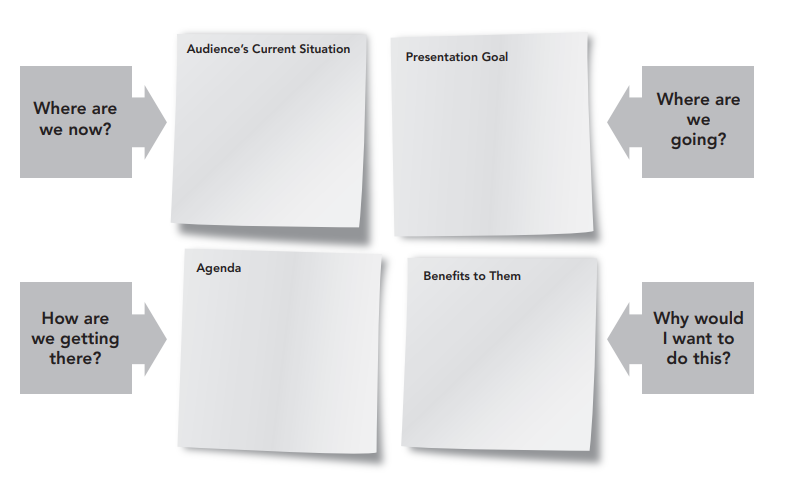
- Dale Ludwig Meetings, Presentations
The Foundation for What Comes Next

A frame consists of four parts. Their order depends on your content and goals, so don’t think of the elements of a frame as steps but as pieces you can reorder as needed. We’ll talk about that more later. A frame should include
- A brief acknowledgment of the current situation
- What your goal is as a presenter
- What benefit you intend your audience to take away from your presentation
- Your agenda
When You Are Preparing Your Presentation
In the planning phase, a solid frame keeps you from ending up in the weeds. It helps you decide what among all the information and ideas you have is really relevant to the conversation at hand. It also forces you to think about the order and priority of the major points you want to make. What do people care about the most? Where does your story start? Where can you summarize, and where do you need to dig into the details? If you plunge into your content without thinking about the framing components, you almost certainly have a lot more frustration and revision ahead of you than if you take the time to work on your frame first.
In the delivery phase, each of the components serves a purpose for your audience. Let’s look at how each part functions and why it benefits both you and your listeners.
Set Context with the Current Situation: “Where are we now?”
This part of the frame is intended to communicate the context in which your presentation takes place. It helps to orient participants who may not be fully up to speed and to show that you understand the context in which your conversation is taking place. At the planning stage when it’s just you at your desk, think about the current situation. This will help you prioritize your points and increase the likelihood that you will choose the correct approach and tone for your presentation. Think about how the same content will be presented differently depending on which statement of the current situation kicks off the presentation:
- “As you know, our CEO has resigned, so there is some uncertainty about marketing spending for next quarter. That said, we’ve got the green light to propose a provisional plan.”
- “As you know, our CEO has stepped down, and the board is excited to bring in new leadership with fresh ideas. Therefore, we have the green light to create a marketing plan.”
The circumstances are materially the same, but the context is quite different.
The current situation is also an opportunity to address whatever elephants might be in the room. While you set up a business-oriented current situation during your planning phase, you should also think about what’s going on with your listeners as you begin.
I once walked into a training engagement with seasoned salespeople, and even before the class started for the day, I sensed some resentment and disengagement. So, I called it out as part of establishing the current situation. Here’s an approximation of what I said: “I’m here today to help you with your sales presentations, but I’m sensing some of you either don’t fully know why you’re here or would rather not be here. Is that something you’d like to discuss?” In the next few minutes, I discovered that my training had not been introduced or positioned well to them, and they expected it to be too elementary and a waste of time. By having that conversation upfront and not ignoring the mood in the room, I could make adjustments to my approach, acknowledge their years of experience and expertise, and move on to hold a successful workshop.
Establish a Clear Goal: “Where are we going?”
It’s important for you to think in advance about what you want to achieve in your presentation and then make that clear to your audience as part of your frame. Articulating your goal during the planning phase forces you to think hard about what you’re really there to do. Will you be sharing information? Asking people to change their minds? Selling a product or service? Once that’s decided, it influences your thoughts about what information, flow, graphics, and questions will get you there. In the meeting, it will answer the question “Where are we going?” and help your audience focus on what’s to be achieved. Some goal statements might look like this:
- “My goal for today is to lay out the basics of the new benefits sign-up process as we switch from Mega Insurance to Giant Healthcare.”
- “What I plan to achieve in this presentation is to get buy-in on the new branding ideas and create a timeline for revisions.”
- “What we need to accomplish today is a list of priorities for Operation Excellence at our Fargo plant.”
You’ll notice that the last one is a “we” goal, which is often appropriate for meetings where responsibility for a successful outcome is shared. For a presentation you’re delivering solo, an “I” goal indicates that you’ve taken responsibility for the outcome.
Emphasize the Benefits for Your Audience: “What’s in it for me?”
Especially after lockdown, remote work, the “Great Resignation,” and everything else we’ve been through lately, it’s especially important to tell your audience outright why your presentation is a good use of their time. Focusing on the audience’s benefits will help you avoid tangents that are interesting but unnecessary. Here are some examples of how to state your benefit to your audience:
- “At the end of this meeting, you’ll understand the new org chart and be able to discuss it effectively with your teams.”
- “The benefit to you is that you can make a more informed choice about which health plan you’d like to choose, and you’ll know who to go to with specific questions.”
- “When we finish up tomorrow, each of you will have created a plan for integrating your employees with those in similar roles at the company we’re acquiring.”
Offer an Agenda: “How are we getting there?”
For detailed information on agendas, check out this article by Barbara, one of our Executive Coaches. Just remember that an agenda is a high-level itinerary, not a complete roadmap. So, stay focused on a few major points—whether your meeting lasts half an hour or three days—and leave out the details.
How to Create a Frame
Making a frame is pretty easy once you get the hang of it. The thought process might be involved depending on your content, but writing the actual frame isn’t. Especially as you’re getting used to this idea, start with four 3 x 3-inch sticky notes. Write a brief, shorthand version of each element of the frame on one sticky note. If you find that you run out of room on one sticky or are using tiny writing to get everything on the note, you’re almost certainly including more information than the frame should have, and you’re probably getting into your actual content. Boil each element down to the essentials.
Next, think about the order that makes the most sense in context.
- A resistant audience might be swayed if they hear about the benefit to them first.
- A new or unfamiliar audience may benefit from understanding the current situation first.
- An audience where people are not sure why they’ve been invited might like to hear your goal or the agenda first.
Play around with the order until it feels right to you.
One question we often get is about what to do when the presenter’s goal is pretty much the same as the benefit to participants. Yes, it would be weird to say, “My goal today is to ensure that you understand the new data inputting process. The benefit to you of this meeting is that you’ll understand the new data inputting process.” In this case a “so that” or “in order to” is a good way to link your intention with their benefit; something like, “My goal today is to ensure that you understand the new data inputting process so that you can get back to work feeling more up-to-speed and less confused than you might right now.”
Keep Your Frame Concise
Delivering the frame helps you establish your seriousness and confidence and that you’re in control. It’s also where you establish your promise to your audience for how you’re going to spend their time. It should take no more than 30-90 seconds to deliver. That’s right, whether you’ll be talking for 30 minutes or three days, your frame should be short and to the point, with no content creeping in.
Here’s an example:

As you can see in this example, there’s no doubt about what you’re there to talk about and why.
Closing Out Your Frame
Your frame also gives you a way to wind up your presentation. Revisiting your goal and benefit is a good way to remind your audience that you did what you set out to do: “Thank you all for participating today. We’ve gone through the steps of the new data input process, and everyone seems to have a good handle on it.” This should take even less time than your introductory framing. It should also include next steps, if any.
Creating a thoughtful, effective frame for a presentation is a valuable first step in ensuring your content is on target during preparation. During delivery, it reassures your audience that their time will be spent wisely and their concerns will be addressed or discussed. It also helps you appear confident and in control before you get into the meat of your content.


